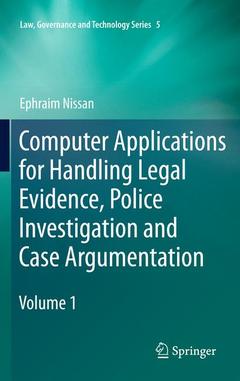Description
Computer Applications for Handling Legal Evidence, Police Investigation and Case Argumentation, Softcover reprint of the original 1st ed. 2012
Law, Governance and Technology Series, Vol. 5
Language: English
Keywords
Analitic Tools; Applications of Computing; Argumentation; Argumentation Methods; Argumentation Tools; Artificial Intelligence & Law; Cadaver Dogs; Computer Forensics; Computer Techniques; Crime Analysis; Crime Detection; Criminal Investigation; Criminal Trials; DNA; Environmental Forensics; Evidence; Evidentiary Value; Exoneration; Face Processing; Facial Reconstruction; Fingerprints; Forensic Archeaology; Forensic Disciplines; Forensic Engineering; Forensic Geology; Forensic Palynology; Forensic Science; Forensic Testing; Gas Soil Surveying; Historical Perspective; Identification Methods; Identity Parades; Intelligence Analysts; Juridic Culture; Law Enforcement; Legal Evidence; Legal Narratives; Legal Professionals; Litigation; Modelling of Reasoning on Legal Evidence; Narrow Evidence Domains; Odorology; Police Intelligence; Polygraph Tests; Prosecution; Questioned Documents Evidence; Reasoning; Reasoning of Jurors; Scent Detection; Self-Incriminating Confessions; Training Police Officers; Wigmore Chart
Publication date: 08-2016
Support: Print on demand
Publication date: 06-2012
1340 p. · 15.5x23.5 cm · Hardback
Description
/li>Contents
/li>Biography
/li>Comment
/li>
This book provides an overview of computer techniques and tools ? especially from artificial intelligence (AI) ? for handling legal evidence, police intelligence, crime analysis or detection, and forensic testing, with a sustained discussion of methods for the modelling of reasoning and forming an opinion about the evidence, methods for the modelling of argumentation, and computational approaches to dealing with legal, or any, narratives. By the 2000s, the modelling of reasoning on legal evidence has emerged as a significant area within the well-established field of AI & Law. An overview such as this one has never been attempted before. It offers a panoramic view of topics, techniques and tools. It is more than a survey, as topic after topic, the reader can get a closer view of approaches and techniques.
One aim is to introduce practitioners of AI to the modelling legal evidence. Another aim is to introduce legal professionals, as well as the more technically oriented among law enforcement professionals, or researchers in police science, to information technology resources from which their own respective field stands to benefit. Computer scientists must not blunder into design choices resulting in tools objectionable for legal professionals, so it is important to be aware of ongoing controversies. A survey is provided of argumentation tools or methods for reasoning about the evidence. Another class of tools considered here is intended to assist in organisational aspects of managing of the evidence.
Moreover, tools appropriate for crime detection, intelligence, and investigation include tools based on link analysis and data mining. Concepts and techniques are introduced, along with case studies. So are areas in the forensic sciences. Special chapters are devoted to VIRTOPSY (a procedure for legal medicine) and FLINTS (a tool for the police). This is both an introductory book (possibly a textbook), and a reference for specialists fromvarious quarters.
Dr. Ephraim Nissan has a long record of research in artificial intelligence (AI), including on AI & Law. He has held research positions at various universities, and since 1994 he is based in London. He has over 320 publications, of which 115 are articles in journals. He also holds an honorary fellowship in the humanities at the University of Manchester. In the late 1980s, his ALIBI model was a seminal project in the area of this book. From 1996, by means of editorial projects, he has had a central role in bootstrapping into existence, as a unified field, the AI modelling of reasoning on legal evidence, and in moving this field into the mainstream of AI & Law scholarship. This effort’s culmination is this book. He has established three scholarly journals, and been a guest-editor about twenty times, of which the topic of six was within AI & Law.
These books may interest you

Forensic Intelligence 129.87 €


